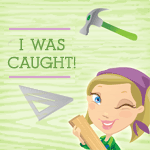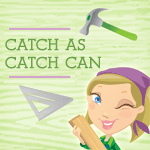Since they are sturdy, I have decided to try my hand at refinishing, but I reeeeeeaaaallly don't want to have to strip layers of black lacquer. That sounds messy and labor intensive.
Could chalk paint be the answer?
Chalk paint is supposedly a miracle substance that can be applied right over previous finishes and eliminates the need for all that loathsome surface prep work, AND lends itself nicely to distressing later. Sounds like my kind of short cut!
TO THE INTERNET! My search for chalk paint led me directly out of my price point and area code. %^&*#$. The major brand looks wonderful, but it is much too expensive for my budget, and the nearest retailer is over two hours from here. %^&*#$, again.
TO THE INTERNET! SOME MORE! This time I searched to see if there was a way to make chalk paint at home. Answer: YES! I came across this post from Elizabeth & Co. that has a tutorial and pictures. I love me some pictures.
Starting this project, I have a little bit of work to do. First, these tables are filthy. One has been living in the basement, while the other has been subjected to the kids. Both were moved to the garage when we painted the living room last week. So, out comes the spray cleaner and a wet wash cloth and each table gets a good scrub.
See these pretty little grooves on the top?
I hate these pretty little grooves. They collect dust, dirt, crumbs, and general schmutz, so that the tables never look clean, EVER. I'm getting rid of these stupid little grooves.
Step one: clean out the grooves. For this I am merely hacking away at the accumulated crap with a flat head screwdriver. It's oddly satisfying. I think it's because I hate these little grooves...did I mention that?
Step two: wood filler. I bought a 1 oz. tube for about $5 at Lowe's. Stupidly, I underestimated how much I'd need and had to purchase a second tube. If I had just gotten the bigger tube to begin with, I'd be out three fewer dollars. *sigh*
The wood filler is pretty much applied the same way you would apply grout or joint compound, i.e. smooshing it into the grooves with a putty knife. In the tighter corners I lost my patience and just used my fingers. Note: This is murder on a manicure. Murder.
Step three: sanding! I know I don't have to sand off the previous finish since I'm using chalk paint, but scuffing it up can't hurt, and I have to sand down the wood filler anyway.
Note: This is messy. And just as bad on a manicure as the wood filler.
After everything was sanded, I gave each table a quick wipe with a wet wash cloth and let them dry while I mixed my paint.
Why, yes. Yes, I am going to add that link every time I write the words wash cloth. Thank you for asking.
I seriously lucked out while looking at the "oops" rack of paint at Lowe's. These are paints that were mixed but not purchased for some reason, and they are deeply discounted.
My quart of paint, very close to the color that I wanted, was only $3.00, saving me TEN BUCKS! This more than makes up for the money I blew on the extra tube of wood filler.
As I said earlier, I am using the recipe for chalk paint from Elizabeth & Co. She uses a container with four equal lines on it for measuring. I bought a one-quart container for about $1.50 that had ounces measured on it.
1) I put in Plaster of Paris up to the 4 oz. line
2) I mixed in enough water to make a smooth, creamy paste
3) I added paint up to the 16 oz. line and mixed!
It really was that simple!
It took two coats to cover the black. Even after two tables, I still had chalk paint left over!
I took my sanding sponge and sanded away the paint in spots to let the black lacquer show through. Maybe I went a little over board, but I like it.
After two coats of Minwax Paste Wax, the tables shine really nicely.
Here's one waiting to hold the presents at my son's birthday party. (See the balloon strings tied to it?)
And the other one is back where it belongs - holding up my coffee while I blog. Amen.
P.S. Want to know the total cost? $23. Yep. I paid 10 bucks for the wood filler, 3 for the paint, and another 10 for the paste wax. The rest of the stuff I already had. Way cheaper than the $180 needed to buy new tables!
Update: Hey, LOOK!


















Thanks for the recipe. I have a bench to paint!
ReplyDeleteI think your experiment was a success. Looks great.
ReplyDeleteHi! I think your tables look fantastic. I use the very similar method of making DIY Chalk paint...even the same wax.
ReplyDeleteI love that shade of green...looks wonderful and your distressing adds character. NOT over done.
Pat
The tables really are nice...great makeover!!! Found you over at Gail's MRL.
ReplyDeleteBeautiful job! I'm so glad the chalk paint recipe worked out for you! And I so appreciate the shout-out! And just look at all the money you saved! Now you can go get a new manicure!!!
ReplyDeleteYour table looks so good. Great job at making your own chalk paint.
ReplyDeleteLove DIY chalk paint! :) Your tables look great, very nice job.
ReplyDeletehint: I buy drywall mud in the gallon bucket in the construction dept at Home Depot (not the paint dept, it's higher there). A gallon of mud will last a long, long time, and you can use it in place of wood filler for a lot of applications. Dries fast, easy to sand.
gail